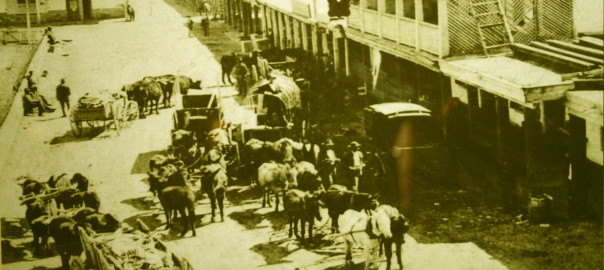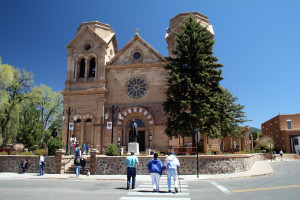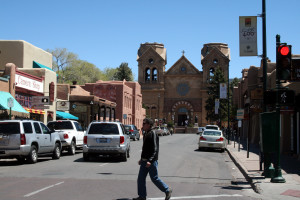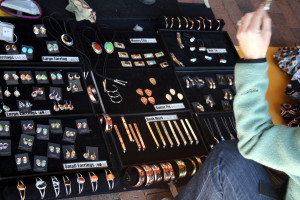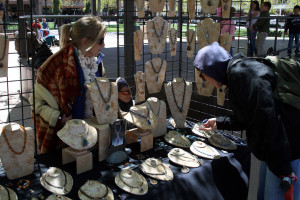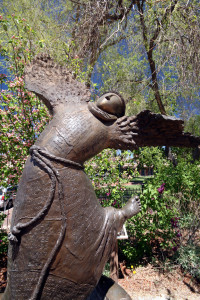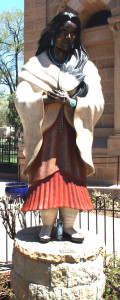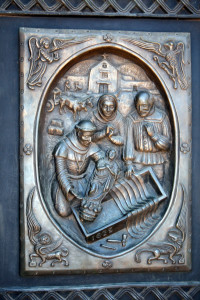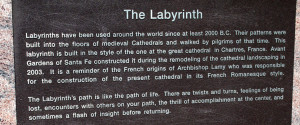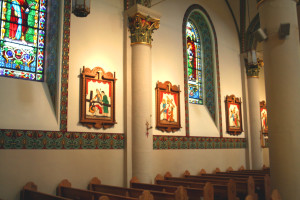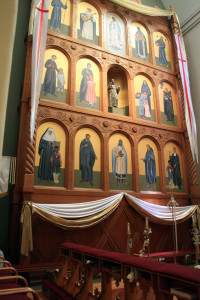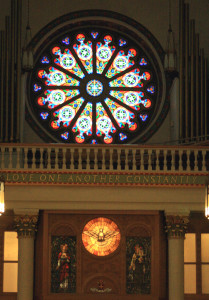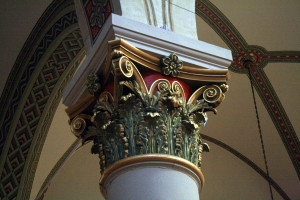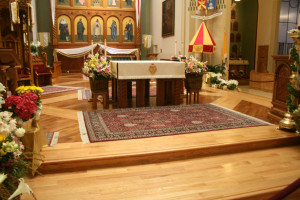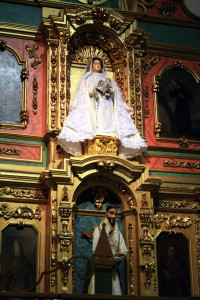Do You Know the Way to Santa Fe?
Between the mid-1920s and 1937, the most popular way to reach Santa Fe was by driving there along Route 66, which took you right into the center of town.  It seems like every town between Chicago and Los Angeles wanted a piece of “The Mother Road,” and then they didn’t anymore, so the route of “The Route” repeatedly changed. A casual google search for a map of Route 66 is likely to turn up subtly different looking roads, only adding to the mystery and confusion over exactly where the “Main Street of America” actually ran.
It seems like every town between Chicago and Los Angeles wanted a piece of “The Mother Road,” and then they didn’t anymore, so the route of “The Route” repeatedly changed. A casual google search for a map of Route 66 is likely to turn up subtly different looking roads, only adding to the mystery and confusion over exactly where the “Main Street of America” actually ran. 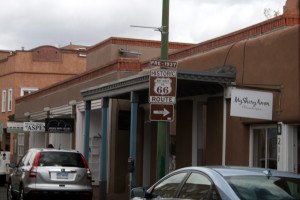 Some versions (incorrectly) include Las Vegas Nevada, others include Santa Fe, while many don’t include either famous city. But Santa Fe’s fame and charm preceded Route 66 by generations, stretching back over 400 years to the year 1608 CE, when the Spanish
Some versions (incorrectly) include Las Vegas Nevada, others include Santa Fe, while many don’t include either famous city. But Santa Fe’s fame and charm preceded Route 66 by generations, stretching back over 400 years to the year 1608 CE, when the Spanish 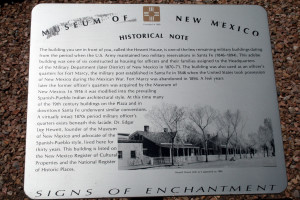 Conquistadores and their Franciscan padres established a
Conquistadores and their Franciscan padres established a 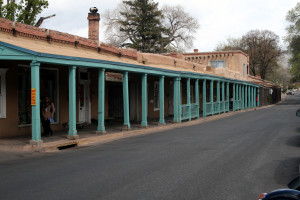 military garrison and church on the location of an abandoned pueblo founded around the year 900 CE. It later became the site of the first foreign war in the Americas when the local pueblo people successfully revolted and expelled the Spaniards for 12 years.
military garrison and church on the location of an abandoned pueblo founded around the year 900 CE. It later became the site of the first foreign war in the Americas when the local pueblo people successfully revolted and expelled the Spaniards for 12 years. 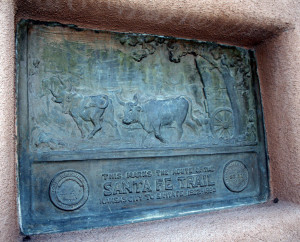 Later still, it became the destination for countless pioneers travelling across the Great Plains along the
Later still, it became the destination for countless pioneers travelling across the Great Plains along the 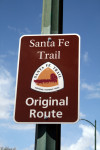 old Santa Fe Trail all the way from Kansas City in covered “Conestoga” wagons. The pioneers were soon followed out of Kansas by the Atchison, Topeka and Santa Fe Railway,
old Santa Fe Trail all the way from Kansas City in covered “Conestoga” wagons. The pioneers were soon followed out of Kansas by the Atchison, Topeka and Santa Fe Railway, 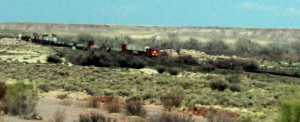 now owned by BNSF (Burlington Northern and Santa Fe Railways) neither of which, despite their names, ever actually served the town of Santa Fe!
now owned by BNSF (Burlington Northern and Santa Fe Railways) neither of which, despite their names, ever actually served the town of Santa Fe!
Last, and perhaps least, the little town of Santa Fe, New Mexico became a destination for us again, for the third time in the last four years – pretty impressive for folks who make a point of not visiting the same place twice! 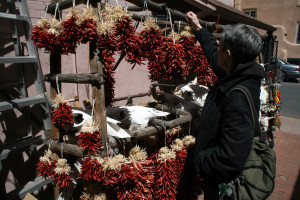 We discovered on our first and second visits here that there is an awful lot to see in and around Santa Fe, not the least of which are a couple of friends we’ve made along the road.
We discovered on our first and second visits here that there is an awful lot to see in and around Santa Fe, not the least of which are a couple of friends we’ve made along the road.
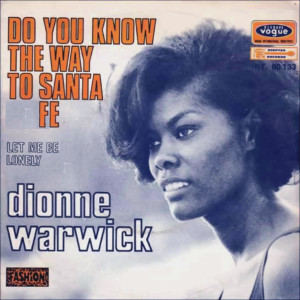
And just to clear up one more mystery about the title of this section…
Dionne Warwick never sang a song called “Do You Know the Way to Santa Fe,” no matter what you may think you’ve seen or heard on the radio! 🙂
From Old Santa Fe to REALLY Old Santa Fe (Pueblo Ogapoge)
The main road east from Gallup to Albuquerque, then northeast to Santa Fe used to be Route 66, but that has largely been replaced by two interstates, I-40 and I-25, but as they say, you just can’t kill a good idea. 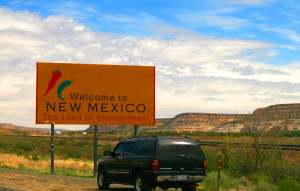 Unlike most interstate journeys, this one really does seem to follow the state motto “New Mexico, Land of Enchantment.” Much of the architecture takes on the character and appearance of the adobe Pueblos that have dotted this ancient land since long before Europeans “discovered” it.
Unlike most interstate journeys, this one really does seem to follow the state motto “New Mexico, Land of Enchantment.” Much of the architecture takes on the character and appearance of the adobe Pueblos that have dotted this ancient land since long before Europeans “discovered” it. 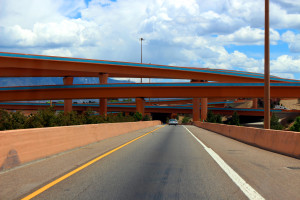 Approaching Albuquerque, you can’t help but notice how the buildings and the landscape blend with one another, the sandstone browns punctuated by tones of turquoise and coppery russets.
Approaching Albuquerque, you can’t help but notice how the buildings and the landscape blend with one another, the sandstone browns punctuated by tones of turquoise and coppery russets. 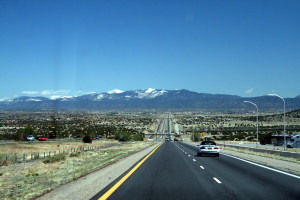 Albuquerque sits in a bowl-shaped valley that can be stunning if the blue skies and puffy white clouds are just right, and the road from there to Santa Fe brings you past a couple of modern Pueblo villages, including Pojoaque Pueblo,
Albuquerque sits in a bowl-shaped valley that can be stunning if the blue skies and puffy white clouds are just right, and the road from there to Santa Fe brings you past a couple of modern Pueblo villages, including Pojoaque Pueblo,  where colorful bridges feature the local place names K’uuyemugeh (“place of the falling rock”) and Posuwaegeh (“drink-water place”).
where colorful bridges feature the local place names K’uuyemugeh (“place of the falling rock”) and Posuwaegeh (“drink-water place”).
As you arrive in the center of town, you find yourself in what looks like a scene from an old Western movie;
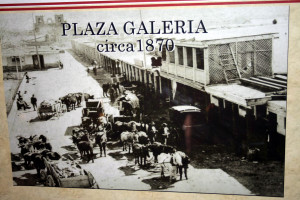
but instead of being a stage set or a replica of the Wild West, you quickly discover that you have indeed traveled back in time, to the 1870s and possibly even earlier! There are changes to be sure, but the architecture and buildings of Santa Fe’s Central Plaza seem to have changed little, aside from the types of vehicles driven by the visitors.
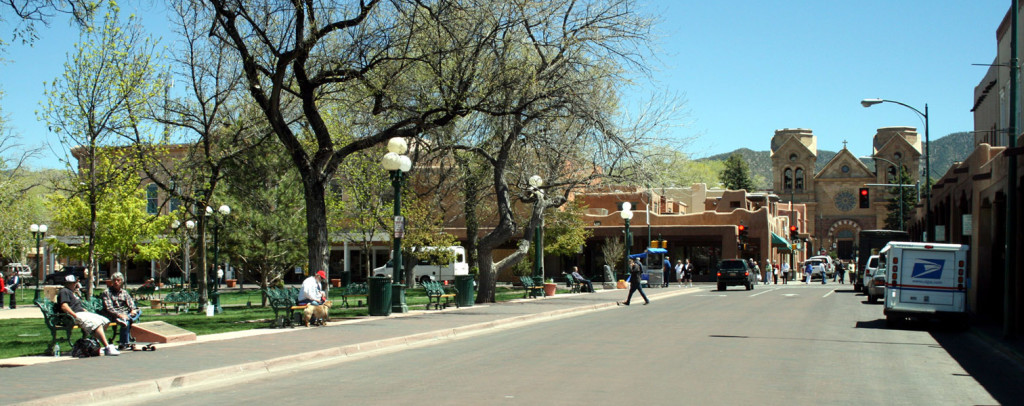
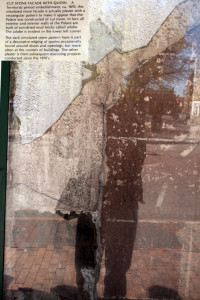
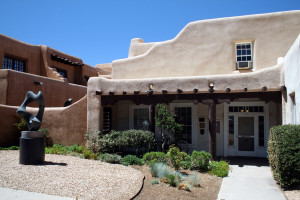 The buildings once occupied by a series of Spanish, Mexican and American military garrisons are now art galleries and museums. The stucco that covers the former “Palacio,” the main building in the Plaza, includes a section that reveals the mud and straw adobe bricks that were used to construct all these buildings so long ago.
The buildings once occupied by a series of Spanish, Mexican and American military garrisons are now art galleries and museums. The stucco that covers the former “Palacio,” the main building in the Plaza, includes a section that reveals the mud and straw adobe bricks that were used to construct all these buildings so long ago.
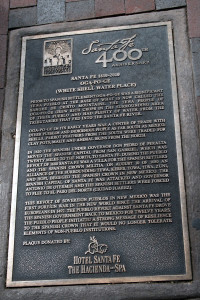
Ogapoge Pueblo was inhabited for over 500 years, but had been abandoned by the Pueblo people for nearly two centuries before the Spaniards arrived. The newcomers built their Central Plaza over the ruins of the Pueblo, establishing it as their capital, complete with military garrisons and a church. They called the settlement “Villa Real de la Santa Fe de San Francisco de Asis” – the “Royal Villa of the Holy Faith of St. Francis of Assisi.“
Fortunately, the name has since been shortened to Santa Fe, or “Holy Faith,” and the Cathedral of St. Francis of Assisi stands on the same spot where the original church once stood.
The Plaza Today – Native Artists and Galleries Galore
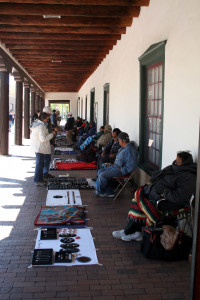 Native artists, whose ancestors may have been among those who drove out the Conquistador garrisons in 1680, now sell their jewelry and artwork along the Plaza, and we couldn’t help but indulge ourselves, buying a silver ring and copper guitar pick.
Native artists, whose ancestors may have been among those who drove out the Conquistador garrisons in 1680, now sell their jewelry and artwork along the Plaza, and we couldn’t help but indulge ourselves, buying a silver ring and copper guitar pick.
History mixes with art as the galleries and shops all around the Plaza include historical descriptions and images of how the buildings were used in the past, including a description of the origins of Santa Fe as the Pueblo Ogapoge. 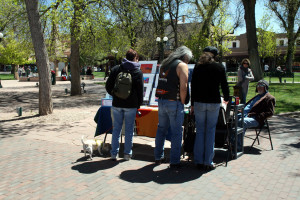 All three times that we have visited Santa Fe, we have seen the Central Plaza bustling with people and activity.
All three times that we have visited Santa Fe, we have seen the Central Plaza bustling with people and activity. 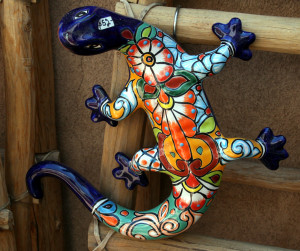
While it is admittedly a bit of a “tourist trap,” it’s definitely a lot more upscale than most. 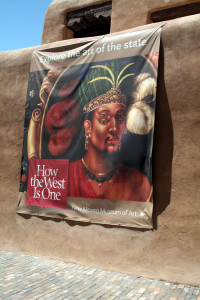 If you venture through the streets around the center of town, you’re overwhelmed by the number and variety of art galleries of every kind.
If you venture through the streets around the center of town, you’re overwhelmed by the number and variety of art galleries of every kind. 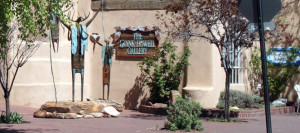 And if you venture even farther afield, you will notice that the city seems to be in the midst of an expansive building boom, all of it within the style of Puebloan architecture, and thoughtfully planned out.
And if you venture even farther afield, you will notice that the city seems to be in the midst of an expansive building boom, all of it within the style of Puebloan architecture, and thoughtfully planned out. 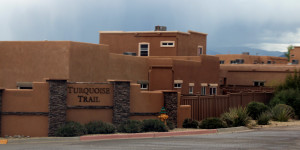 We’re told that Santa Fe is the third largest art market in the United States, behind only New York and Los Angeles.
We’re told that Santa Fe is the third largest art market in the United States, behind only New York and Los Angeles. 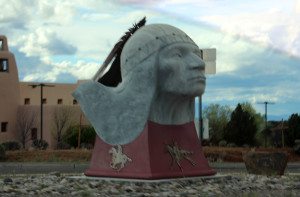 Not bad for a pretty little town that boasts a dry, temperate climate.
Not bad for a pretty little town that boasts a dry, temperate climate.
The Cathedral – French Influence in a Spanish Town
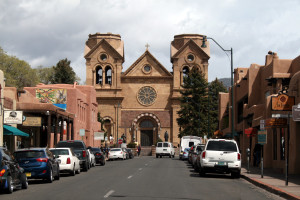 The magnificent Cathedral of St. Francis of Assisi that stands today at the end of the Old Santa Fe Trail a block away from the Central Plaza was built between 1869 and 1886 on the site of older churches dating back to 1626 at the time of the Spanish Conquistadores.
The magnificent Cathedral of St. Francis of Assisi that stands today at the end of the Old Santa Fe Trail a block away from the Central Plaza was built between 1869 and 1886 on the site of older churches dating back to 1626 at the time of the Spanish Conquistadores. 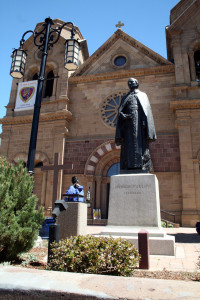 The builder, Jean Baptiste Lamy, was a French prelate who would become the first Archbishop of Santa Fe. The local Spanish clergy didn’t accept him at first, pledging their continued allegiance to the bishop of Durango, Mexico, but since the territory of New Mexico had just been transferred to the control of the United States at the end of the Mexican War, Pope Pius IX decided to quickly adjust to the new political reality.
The builder, Jean Baptiste Lamy, was a French prelate who would become the first Archbishop of Santa Fe. The local Spanish clergy didn’t accept him at first, pledging their continued allegiance to the bishop of Durango, Mexico, but since the territory of New Mexico had just been transferred to the control of the United States at the end of the Mexican War, Pope Pius IX decided to quickly adjust to the new political reality. 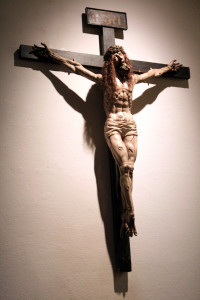 Lamy went to great lengths to assert control over the region on behalf of the Catholic Church, traveling to Mexico with the leader of his opposition to obtain the formal recognition of his (Lamy’s) authority over New Mexico, replacing priests who continued to oppose him, and bringing members of the Sisters of Loretto from his old diocese in Kentucky to establish the first English speaking schools in the New Mexico territory.
Lamy went to great lengths to assert control over the region on behalf of the Catholic Church, traveling to Mexico with the leader of his opposition to obtain the formal recognition of his (Lamy’s) authority over New Mexico, replacing priests who continued to oppose him, and bringing members of the Sisters of Loretto from his old diocese in Kentucky to establish the first English speaking schools in the New Mexico territory. 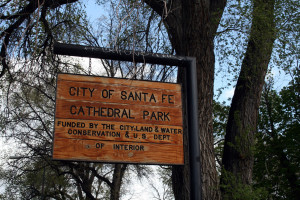 The Cathedral in Santa Fe is an artistic masterpiece, both inside and outside, and even today, it makes a bold statement about its own sense of importance in the Santa Fe community. Archbishop Lamy also built the Loretto Chapel where the Sisters set up their school.
The Cathedral in Santa Fe is an artistic masterpiece, both inside and outside, and even today, it makes a bold statement about its own sense of importance in the Santa Fe community. Archbishop Lamy also built the Loretto Chapel where the Sisters set up their school. 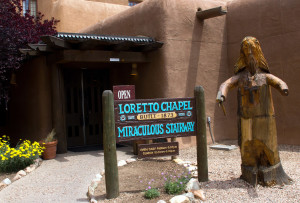 Loretto Chapel is no longer a Catholic Church, but it has been preserved as a museum that is both beautiful and mysterious – in fact, it deserves its very own post, which will be coming up in the near future!
Loretto Chapel is no longer a Catholic Church, but it has been preserved as a museum that is both beautiful and mysterious – in fact, it deserves its very own post, which will be coming up in the near future!
Outside the Cathedral – The Bishop, the Saints, and the Labyrinth
As you might guess, the artwork and statuary in the large plaza outside the Cathedral includes both the unusual and the unexpected.


An imposing statue of Archbishop Lamy, the Cathedral’s founder, stands in the spot most visible from every angle. Two statues of St. Francis – one with a dog or wolf and a bird, the other
a whimsical bronze of St Francis dancing on the water, his garments inscribed with quotes about “Sir Brother Sun” and 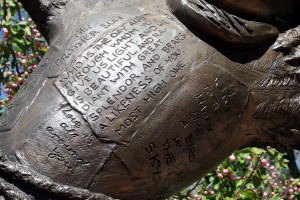 another that says “Love Is All Around You” … who knew St. Francis covered the Troggs?
another that says “Love Is All Around You” … who knew St. Francis covered the Troggs?
A very colorful statue of the Algonquin-Mohawk saint, Kateri Tekakwitha – whose only connections to Santa Fe seem to be that she was baptized by Franciscans in what is now upstate New York, and the fact that many First Nations people live in and around Santa Fe and throughout New Mexico. 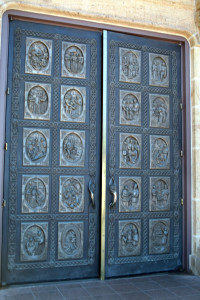 Two huge bronze doors, each adorned with
Two huge bronze doors, each adorned with
ten reliefs of various events in Franciscan history, form the entrance to the Cathedral. There is also a large labyrinth, reminiscent of the cathedrals of France, whose influence is seen both inside and outside the cathedral.
A plaque explains the significance of the labyrinth;
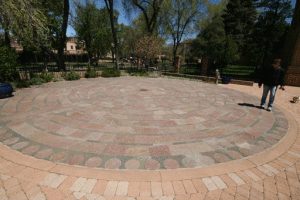
we’re not sure whether Cookie appreciated its full significance, but you can click on this picture and decide for yourself!
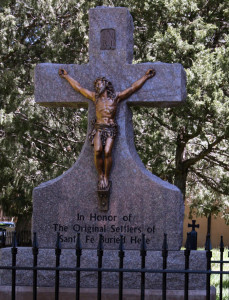 Finally, a well-kept burial ground dedicated to “The original settlers of Santa Fe Buried Here”… presumably referring not to the residents of Ogapoge Pueblo, or their descendents who were killed here, but to the Friars and Conquistadors who killed them!
Finally, a well-kept burial ground dedicated to “The original settlers of Santa Fe Buried Here”… presumably referring not to the residents of Ogapoge Pueblo, or their descendents who were killed here, but to the Friars and Conquistadors who killed them!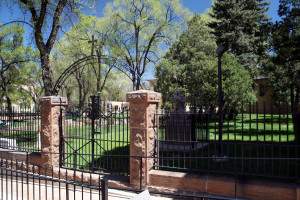
Inside the Cathedral – A Blend of French, Pueblo, and Spanish
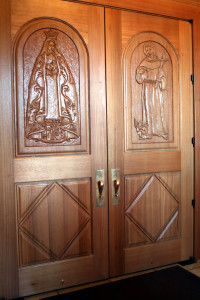 As you enter the Cathedral, you pass through more beautiful doors, this time made of hardwood, with impressive carvings of the Virgin Mary and St. Francis.
As you enter the Cathedral, you pass through more beautiful doors, this time made of hardwood, with impressive carvings of the Virgin Mary and St. Francis. 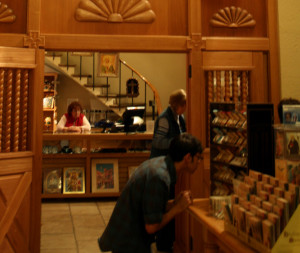 Then you encounter what looks like a gift shop filled with church tchotchkes and cash registers – a bit jarring at first, but hey, why try to hide what it’s really all about?
Then you encounter what looks like a gift shop filled with church tchotchkes and cash registers – a bit jarring at first, but hey, why try to hide what it’s really all about? 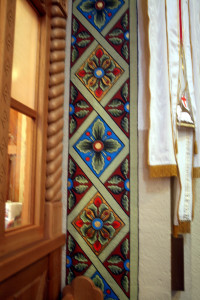 When you enter the church itself, you are struck by a suffusion of Puebloan colors, brilliant stained glass windows, an enormous baptistery, a huge altar screen with fourteen painted panels and a statue of St. Francis in the center.
When you enter the church itself, you are struck by a suffusion of Puebloan colors, brilliant stained glass windows, an enormous baptistery, a huge altar screen with fourteen painted panels and a statue of St. Francis in the center.
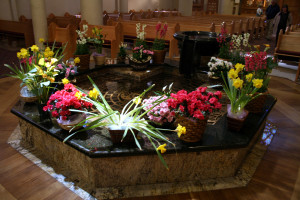
The statues in the church are also unusually lifelike, not the bland marble seen in many Catholic churches. 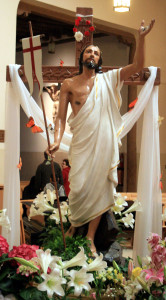 The Way of the Cross – often called Stations of the Cross in other churches – is composed of 14 panels painted in the same sandstone browns, turquoise and russet colors that decorate the rest of the church, and includes an additional panel describing the originator of this devotion as St Francis himself.
The Way of the Cross – often called Stations of the Cross in other churches – is composed of 14 panels painted in the same sandstone browns, turquoise and russet colors that decorate the rest of the church, and includes an additional panel describing the originator of this devotion as St Francis himself. 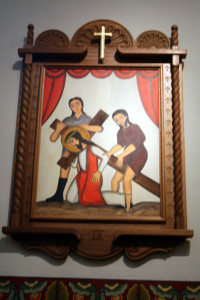
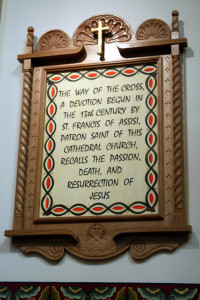 The church is among the most beautiful we have ever seen, and is a real masterpiece, blending stained glass windows of the Apostles imported from France, a very impressive rosetta window over the choir loft,
The church is among the most beautiful we have ever seen, and is a real masterpiece, blending stained glass windows of the Apostles imported from France, a very impressive rosetta window over the choir loft, 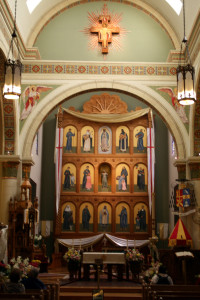 and the influences of both the Spanish and Puebloan influences that have been part of Santa Fe throughout its history.
and the influences of both the Spanish and Puebloan influences that have been part of Santa Fe throughout its history.
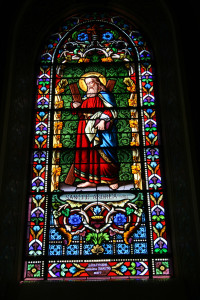
The “Conquistadora” of Peace!?
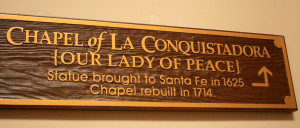
In the corner of this impressive Cathedral there’s something of a head-scratcher, especially for anyone familiar with the history of the Roman Catholic Church in Santa Fe. 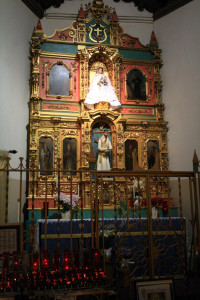 A special chapel is dedicated to 4-foot tall historical relic called “La Conquistadora,” first brought from Spain to Santa Fe in 1625, and rescued from destruction as the Spaniards fled to Ciudad Juarez in the Pueblo Revolt of 1680. Twelve years later, the statue was used to lead the Conquistadors into battle in the reconquest of Northern New Mexico.
A special chapel is dedicated to 4-foot tall historical relic called “La Conquistadora,” first brought from Spain to Santa Fe in 1625, and rescued from destruction as the Spaniards fled to Ciudad Juarez in the Pueblo Revolt of 1680. Twelve years later, the statue was used to lead the Conquistadors into battle in the reconquest of Northern New Mexico.
The statue is still used in annual parades celebrating the return of the Spanish Conquistadors to Santa Fe, but recently its name was changed to “Our Lady of Peace!”
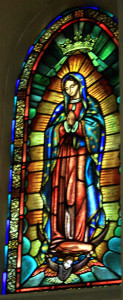
The odd “translation” seems to be an attempt to assuage any lasting resentments the local Pueblos whose ancestors suffered in the violent history of this symbol of oppression. The older name has not faded however, giving rise to the strange juxtaposition of its two contradictory names on the plaque outside the chapel. The stained glass window of Our Lady of Guadelupe near the Conquistadora chapel might appeal more to indigenous people than the odd mistranslation of the centuries old statue.
The Shrine of the Archbishops
Many Catholic Churches include somewhat smaller side altars on each side of the main altar. They’re often dedicated to the Virgin Mary and one other saint, sometimes St. Joseph, or the saint the church is named for.
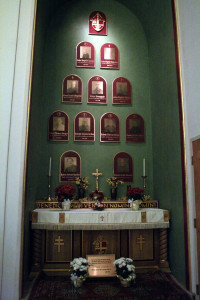
In the Santa Fe Cathedral, the side altar on the right is not dedicated to any saints at all; instead, it features a “shrine” to the Archbishops of Santa Fe, including portraits of every Archbishop since Jean Baptiste Lamy, right up to and including Michael Sheehan, who retired this year. We can speculate about how many saints are among these portraits, but one in particular stood out: 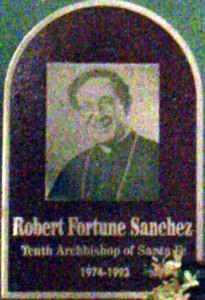 Sheehan’s immediate predecessor, Robert Sanchez, who “resigned” in disgrace in 1993 at the age of 59 amid allegations of rape, public admissions of inappropriate relationships with young women including teenagers, and his failure to act on reports of abuse by priests, both under his supervision and at the notorious “Club Ped,” a largely unsupervised “treatment center” for pedophiles from all over the country that operated for decades within his archdiocese.
Sheehan’s immediate predecessor, Robert Sanchez, who “resigned” in disgrace in 1993 at the age of 59 amid allegations of rape, public admissions of inappropriate relationships with young women including teenagers, and his failure to act on reports of abuse by priests, both under his supervision and at the notorious “Club Ped,” a largely unsupervised “treatment center” for pedophiles from all over the country that operated for decades within his archdiocese.
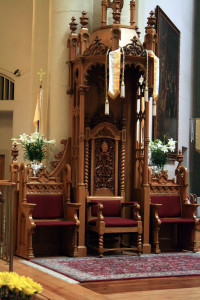
As sad as this episode was for the Hispanic members of the archdiocese, it was far worse for Sanchez’s victims. But there he is, honored in the narcissistic Shrine to the Archbishops in the Santa Fe Cathedral!
Free Advertising for Catholic Alternatives!
Santa Fe is a very diverse, vibrant city filled with a sense of creativity and a free spirit. It’s also a city filled with a great deal of religious imagery and symbolism, so it’s not surprising to find that there is a great deal of diversity in its religious expression. In fact, there are as many as sixteen alternative Catholic denominations in Santa Fe in addition to the Roman Catholic Church that operates the Cathedral. That’s right, 16 alternative Catholic denominations; that’s not counting the many evangelical Christian groups and mainline Protestant denominations. How do I know this? Because the Roman Catholic Archdiocese of Santa Fe has seen fit to enumerate all 16 “Local Scismatic Churches,” including their street addresses and pastor’s names, on the diocesan website!
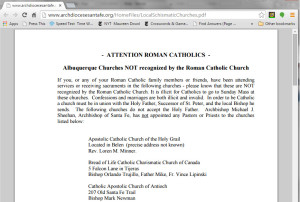
Despite the dire warnings and theological errors in the introductory paragraph, it strikes me as free advertising… in effect saying, “If you don’t like what you’re hearing or what’s been going on in the Roman Catholic church, here’s a list of other Catholic churches not under our Archbishop’s control that you might want to check out! In our next post about some of the artists of Santa Fe, you’ll meet a wonderful couple who are leaders of the Catholic Apostolic Church of Antioch in Santa Fe, a Catholic church that has solved the “problems” of women priests, married clergy, homophobia, authoritarian dogma, and papal infallibility… AND they’ve returned the word “catholic” to what it actually means, which is “universal,” not “exclusively Roman”!
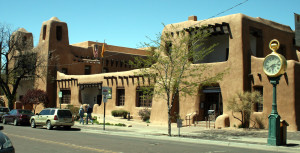 Hope you enjoyed this little tour of downtown Santa Fe…
Hope you enjoyed this little tour of downtown Santa Fe…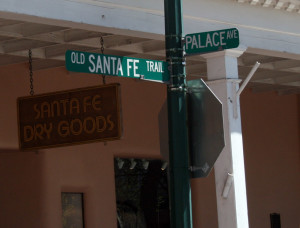
As Cookie likes to say, “It’s a Big Country, and one little dog wants to see it all!”
Happy Trails to you…
